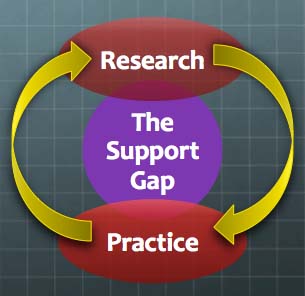Over the years, I have visited many agencies doing their work in the service of people with disabilities. In the process I’ve met many caring staff. But caring, while important, is really far from enough for people with disabilities to succeed. We also need to understand people’s goals and how to help them get there. A big problem we face is what I call the “Support Gap.”
The Support Gap has really two components.
One relates to the flow from research to practice. It is the difference between what research has already uncovered (what we should know how to do), and what we actually do in the disability field. The size of this gap is striking. Disability thinkers have developed various impressive approaches, even technologies, if you will. We now know so much more about life planning, for example, than 20 years ago. There are a number of books and other resources available on ways to facilitate person-centered planning using various approaches. The same is true about job development and support, community living, environmental modification, assistive technology, positive behavioral support, and so on.
Unfortunately, in a system serving over a million people with developmental disabilities, most providers have not come close to using such state of the art approaches as their standard. It’s not for lack of desire; but funding, turnover, inefficient or unavailable training are too often the case they face.
The second component relates to what research hasn’t studied, or the flow from practice to research. It seems to me that anecdotally and based on studies, we have good reason to believe generally that person-centered, community approaches lead to superior results for people with disabilities. And philosophically, it makes a great deal more sense to focus on individual capacities and desired futures as opposed to deficits and remediation.
But frankly, there is little quality research to support how best to provide these kind of services. What’s more, we know practically nothing about what specific approaches within the general person-centered paradigm work better, or when or how to use them in certain types of situations, such as in careers, community inclusion, or housing.
Consider current housing models used for people with disabilities. The variation in cost for different residential homes is huge. Some institutional settings can run upwards of $200,000 US per resident annually, while family support or more individualized supported living costs a fraction of that amount. Even group home costs range widely from state-to-state.
Even more important than cost, the quality of life experienced in these various settings also varies widely from model to model, including within a model from place to place. Think of it, two different six-person group homes just miles apart can produce wide-ranging outcomes in life experience and cost.
It should trouble policymakers and taxpayers that so little is known about the outcomes of spending billions of dollars. As a result, the field argues about models on a philosophical level – what is the best approach from a cultural perspective, or whether closing an institution removes “choice,” for instance. We really need to align research and practice more efficiently. Then as we learn the answers, we can begin to align the system to what works best and is most cost-efficient, and at the same time, aligning our supports to be non-discriminatory and socially just.

